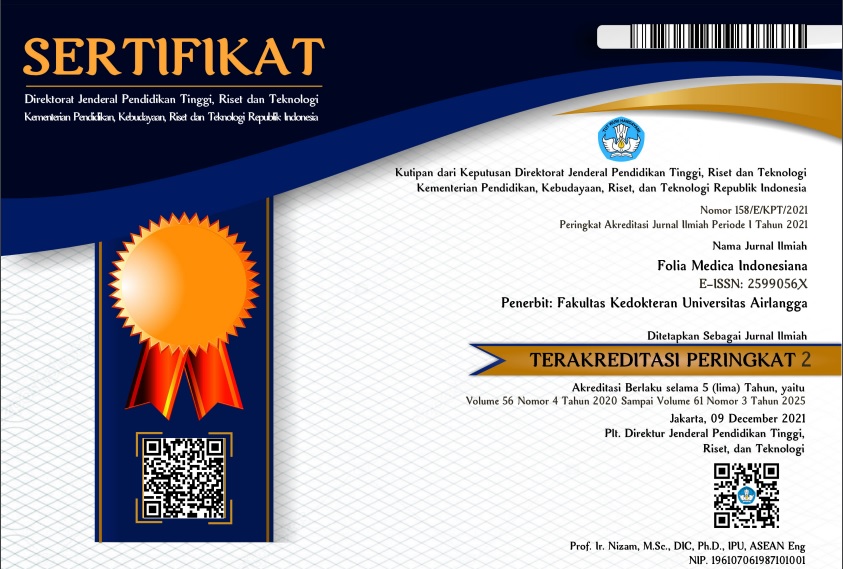ORCID ID
Gondo Mastutik: https://orcid.org/0000-0002-1681-0222, Alphania Rahniayu: https://orcid.org/0000-0002-5059-7875, Isnin Anang Marhana : https://orcid.org/0000-0002-4627-0511, Mochamad Amin: https://orcid.org/0000-0001-7005-5267, Heru Fajar Trianto: https://orcid.org/0000-0003-1083-0078, Reny I'tishom: https://orcid.org/0000-0002-9971-7786
Abstract
Highlights: 1. In this study, new primers designed using the semi-nested polymerase chain reaction (PCR) method were utilized to identify MAGE-A11 and MAGE-A12 expressions in specimens collected from core biopsy, forcep biopsy, and bronchoalveolar lavage. 2. The histopathological analysis revealed positive expressions of MAGE-A11 and MAGE-A12 in specimens diagnosed with non-small cell lung cancer (NSCLC) as well as in specimens with no malignant cells. 3. This study provides evidence indicating that the detection of messenger ribonucleic acid (mRNA) of MAGE-A11 and MAGE-A12 by nested reverse transcription PCR can improve the accuracy of lung cancer diagnosis. Abstract The melanoma antigen gene (MAGE) belongs to the group of cancer-testis antigens that are exclusively expressed in germ cells but may be re-expressed in cancer cells. The highly expressed MAGE-A subfamily in lung cancer may potentially be a diagnostic and prognostic biomarker. This study aimed to identify MAGE-A11 and MAGE-A12 expressions in lung tumors obtained from core biopsy, forceps biopsy, and bronchoalveolar lavage specimens. A cross-sectional observational study was conducted on 90 patients clinically diagnosed with lung tumors. These patients received core biopsy, forceps biopsy, and bronchoalveolar lavage interventions after ethical approval was obtained. The complementary deoxyribonucleic acid (cDNA) quality was assessed by the polymerase chain reaction (PCR) of glyceraldehyde-3-phosphate dehydrogenase (GAPDH). The assessment was performed to ascertain if all specimens exhibited positive PCR amplification of the GAPDH gene. MAGE-A11 and MAGE-A12 were identified through a semi-nested reverse transcription PCR. The positive results were detected by measuring the PCR products, with MAGE-A11 and MAGE-A12 at base pairs (bp) of 858 and 496 in the first and second rounds, respectively. The expressions of MAGE-A11 and MAGE-A12 were observed in 3 (3.33%) and 40 (44.44%) out of 90 specimens, respectively. The prevalence rate of non-small cell lung cancer (NSCLC) was 31.11% (28/90). Among these cases, 3.57% (1/28) showed the expression of MAGE-A11, while 32.14% (9/28) exhibited the expression of MAGE-A12. Sixty-two (68.89%) out of 90 patients were diagnosed with no tumor cell malignancy. Out of 62 cases, 2 (3.23%) exhibited the expression of MAGE-A11, while 31 (50%) demonstrated the expression of MAGE-A12. MAGE-A11 and MAGE-A12 were detected in NSCLC and certain specimens with a pathological diagnosis that indicated the absence of malignant cells. In conclusion, MAGE A11 and MAGE A12 have potential markers to improve the pathological diagnosis of lung cancer. Further investigation is necessary to explore the expression of MAGE-A in correlation with lung cancer progression.
Keywords
Cancer, lung cancer, melanoma antigen gene A, mortality, reverse transcription polymerase chain reaction (RT-PCR)
First Page
363
Last Page
369
DOI
10.20473/fmi.v59i4.50477
Publication Date
12-10-2023
Recommended Citation
Mastutik, Gondo; Rahniayu, Alphania; Isnin Anang Marhana; Amin, Mochamad; Trianto, Heru Fajar; and I'tishom, Reny
(2023)
"Expression of Melanoma Antigen Genes A11 and A12 in Non-Small Cell Lung Cancer,"
Folia Medica Indonesiana: Vol. 59:
No.
4, Article 8.
DOI: 10.20473/fmi.v59i4.50477
Available at:
https://scholarly.unair.ac.id/fk-fmi/vol59/iss4/8






